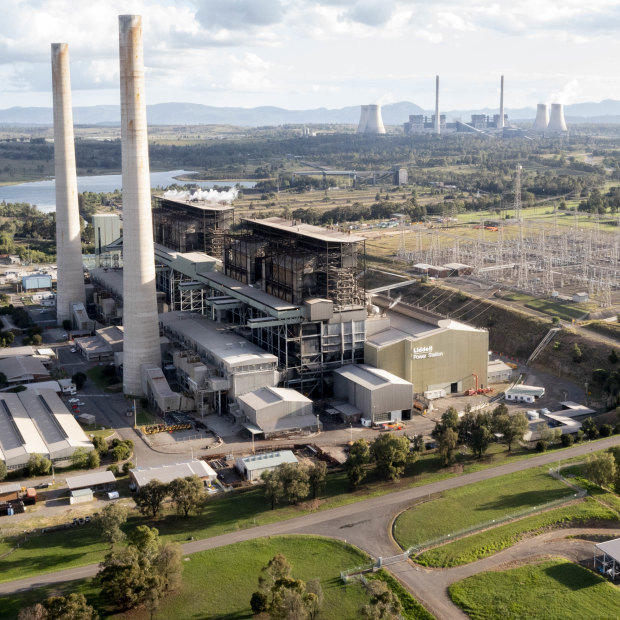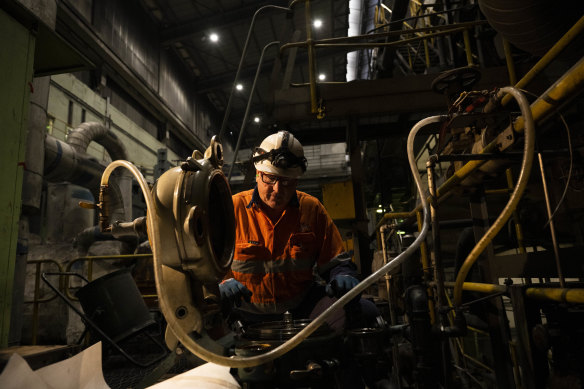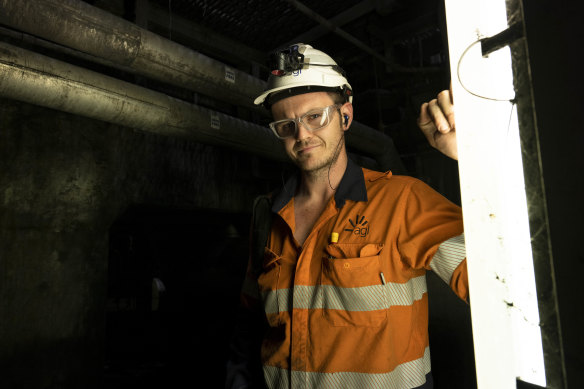By Laura Chung and Janie Barrett
The Liddell Power Station in the NSW Hunter Valley opened in 1971 and at one point was the most powerful generating station in Australia. Credit:Janie Barrett
Save articles for later
Add articles to your saved list and come back to them any time.
The two giant 168-metre concrete chimneys at Liddell’s coal-fired power station have dominated the skyline in their slice of the Hunter Valley for half a century. But their days are numbered. This month Liddell’s owner, electricity giant AGL, will switch off the final unit of the station and begin a two-year process of demolishing what’s left. The towers will be blown up. Trucks will cart steel and concrete away from the site. And workers will hang up their hard hats.
The demolition will represent the end of an era in the Hunter region, but the power station’s closure also holds great national significance. Liddell offers a blueprint as to what the future could hold for the remaining 18 coal-fired power stations around the country. That future is mostly green, with companies hoping to transition the sites into low-carbon industrial energy hubs, with cleaner and cheaper technology.
Flicking the off switch
For Liddell’s owner, electricity giant AGL, the process is the end of a seven-year quest to figure out how best to close the site and what to do with it next. It involved a specialist task force, dedicated to ensuring not only the technical aspects run smoothly, but also that the hundred-strong workforce is supported.
One unit of the station was closed last year, and the remaining three will switch off on April 28. After that, there’s a lot of work to get the site ready for its next chapter.
In the following six months, equipment will be cleaned and dried out. Next, over two years, parts of the station will be gradually removed. They include the large 168-metre chimneys, the 300-metre-long boilers that stand 70 metres high, and the main building infrastructure.
More than 90 per cent of the materials in the power station are expected to be recycled during demolition, including 70,000 tonnes of steel, which is more than the total weight of the steel works for the Sydney Harbour Bridge.
The site will then be levelled using crushed concrete, and preparations will begin to herald the site into the future – turning it into an integrated, low-carbon industrial energy hub.
This will include a grid-scale battery. Planning approval has already been granted for a 500MW/2GWh grid-scale battery. A feasibility study for a hydrogen facility is under way in a partnership with billionaire Andrew Forrest’s company Fortescue Future Industries (FFI), and the company is also exploring solar thermal storage, wind, and energy-to-waste options. Legacy coal-fired stations such as Liddell are located in the best-connected areas to the electricity grid in regional Australia – making them ideal for renewable energy projects.
The transition of the site is expected to start early next year and run until 2026.
Initially, the company considered extending the station’s life, but huge costs and ageing infrastructure left it with only one clear option: to transition the site into a renewable energy hub.
AGL’s chief operating officer, Markus Brokhof, said the project would be the company’s largest decarbonisation project, ending the release of 8 million tonnes of CO2 that the station has been pumping into the atmosphere every year.
“AGL wants to be the lighthouse and Liddell should be the lighthouse project,” he says.
However, AGL was the biggest Australian direct emitter in 2021 – pumping 42.2 million tonnes into the atmosphere. Energy Australia, Stanwell Corporation and Origin Energy pumped out 17.9 million tonnes, 17.1 million tonnes and 16 million tonnes respectively. Despite its emissions record, AGL is also Australia’s largest private owner and operator of renewable energy assets, with more than 1790 megawatts of capacity in operation.
The International Energy Agency has said that coal-fired power stations need to be phased out by 2040, and exploitation and development of new oil and gas fields need to stop if the world is to have a chance of limiting the global temperature rise to 1.5 degrees and achieving net-zero emissions by 2050.
Australia’s electricity generation relies heavily on coal-powered generators, which supply up to 65 per cent of the country’s power needs. But as the lifespan of coal power draws to a close, and investment in renewables grows, fossil fuel companies are forced to decide what they do with their increasingly redundant infrastructure. Many have gone, or plan to go down, similar routes to Liddell and transition to cleaner and cheaper renewable energy sites.
Peter Barry working at the Liddell Power Station.Credit:Janie Barrett
Some plan to follow a similar route to Liddell and build batteries on the sites, while others are yet to release their plans post-closure.
Liddell opened in 1971, and at one point was the most powerful generating station in Australia. In a year, the station produced about 6000 GWh of electricity – enough power for approximately 750,000 average Australian family homes. Liddell, and nearby Bayswater station, also owned by AGL, provide up to 30 per cent of NSW’s power supply.
But as the station’s closure draws nearer, the market is concerned about ensuring there is enough energy once Liddell and similar stations are switched off.
Will our lights go out?
Perhaps one of the biggest concerns for the government and market will be ensuring reliable energy as coal-fired power stations are taken offline. In the case of Liddell, Brokhof says the company has given the market plenty of notice to prepare for the station’s closure, and he’s confident there will be enough energy and capacity.
The Climate Council’s head of advocacy, Dr Jennifer Rayner, says Liddell demonstrates that smooth transitions from fossil fuel projects to renewable energy ones are possible. In comparison, Victoria’s Hazelwood coal-fired power station closed within six months of notifying the market and left authorities scrambling to minimise the blow from the loss of one-fifth of the state’s generation capacity.
Following the station’s closure, wholesale prices increased to about 85 per cent in 2017, and the state flipped into becoming a net importer of electricity in the second half of 2017.
Ensuring prices remain stable is the responsibility of the federal government and the Australian Energy Market Operator (AEMO). The latter is not predicting any major electricity shortfalls in the coming year, but it warns increased investment in renewables and replacement storage is needed to ensure there are no blackouts.
AEMO estimates that by 2030, up to 60 per cent of Australia’s coal-fired power could be retired, and 83 per cent of the country’s total power needs will come from renewables. But there’s a long way to go. The Clean Energy Council says that large-scale renewable energy projects need to roughly double the current pace of deployment to stay on track for the federal government’s declared 82 per cent by 2030 target, which is not legislated.
The main challenge will be getting state and federal governments and private investors to work together to increase investment in replacement generation, storage and transmission capacity, says Christiaan Zuur, the Clean Energy Council’s policy director of market, grid and investment.
“We need to move away from the mentality of the ‘just in time’ type of investment that we’ve traditionally followed, to a world where we recognise that it is far better to go a bit earlier than to go a little bit late,” he says.
He adds that, while the cost of pushing closure dates forward might be costly initially, failing to ensure systems is adequately prepared could drive a price spike and bring blackouts.
Jarred Burns will soon be hanging up his hard hat at Liddell.Credit:Janie Barrett
“The end of coal is going to happen – we can’t stop it from happening nor should we. But we need to focus on bringing forward that replacement capacity to keep the lights on,” he says. “The programs are in place, we are hearing the right noise at all levels of government, we just need to accelerate things.”
Already, the incoming NSW Labor government is bracing itself for a headache further down the track. New Energy Minister Penny Sharpe said this week that, while the electricity grid would manage with the loss of Liddell, the closure could present difficulties for baseload power requirements. She noted that more renewable projects were in the pipeline, but ongoing effort was needed to continue attracting investment.
Tim Buckley, the director of transition analysts Climate Energy Finance, says years of delayed federal climate and energy policies under the Liberal-National government have slowed down Australia’s renewable energy transition.
But since the federal Labor government took office last May, applications for new renewable energy projects have jumped from 64 to 95, according to a federal list of energy projects, ranging from small solar farms to the mammoth Star of the South wind project to be built on the Gippsland coast.
The number of active projects in the renewables sector now exceeds the number of coal and gas projects up for approval by federal authorities.
Buckley says the key to ensuring ongoing grid reliability in the shift to renewable energy generation is a greater variety of energy sources, with offshore wind farms, pumped hydropower storage, batteries and solar playing greater roles within the next 12 years. He believes that, despite the political delays, increased investment will ensure the lights remain on without any major outages.
“Geographic and technical diversity is the key enabler of this,” he says.
Energy giants are also taking note of the increased investment in renewable projects. Many are moving the closure of their coal-fired power stations forward. For example, AGL announced Loy Yang A Power Station in Victoria would close 10 years earlier than previously planned – now in 2035 – and Origin Energy will shut down its NSW Eraring coal-fired power station as early as 2025. The company intends to build a large-scale battery on site in its place.
Jackson Channon’s family has had a long association with the plant.Credit:Janie Barrett
Brokhof has indicated that if AGL can close Bayswater and Loy Yang earlier, it will do so. The decision will be dependent on increased investment in renewables and in firming capacity. However, AGL does not forecast that the grid will be equipped to handle the retirement of more of its coal-fired generators before the current dates it’s provided to the market.
For now, workers at Liddell will focus on saying goodbye to the landmark that has been a constant on their horizon for decades. Past and current workers will gather on the front lawn for a picnic following the station’s closure, sharing food and their memories. Among them will be Jackson Channon. He wouldn’t exist without the station. His parents met while working there and, decades before that, his grandfather drove a cement truck when the station was built in the late 1960s.
Channon knows his grandfather would be proud he continued the family’s legacy of working at the site. He’s one of the thousands who have passed through the doors, helping to keep electricity flowing to homes across NSW.
As Liddell’s closure draws nearer, his family history never is far from his mind.
“You are more thinking about this place closing down and how many memories I have out here,” he says.
“All the jobs I’ve done: you get a job on a Friday afternoon and fix it, and you think back on those jobs … The not-so-good jobs where you get covered in coal and ash, but once it closes it will be something to think about – the family aspect of it. This place had three generations go through here which is definitely a big thing.”
Get to the heart of what’s happening with climate change and the environment. Our fortnightly Environment newsletter brings you the news, the issues and the solutions. Sign up here.
Most Viewed in Environment
Source: Read Full Article






